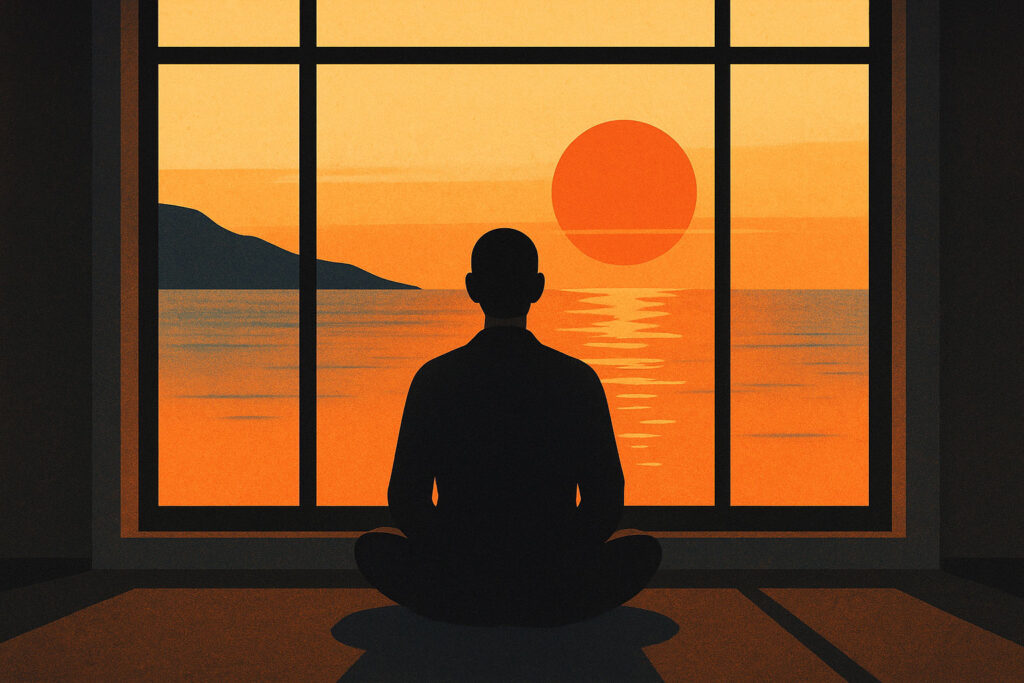
Breathing Your Way Back Home
A Buddhist parable of a blind turtle inspires reflection on life’s rarity, balancing samsara’s struggles with presence and spiritual homecoming.

Over the past few weeks, I have been enjoying a documentary series on HBO called 100 Foot Wave. This is the second season I have watched and it has been a fascinating glimpse into the lives of big wave surfers and the wild adrenaline addiction they all share. As the title suggests, this is big wave surfing at its most extreme and most dangerous. But what I realized is that this documentary is really a study of risk tolerance and how differently we all relate to it in our lives. It is about our willingness to take on risk and face failure and the way that determines the arc of and the meaning of our lives. I just never imagined that Leo DiCaprio and Big Wave surfers were cut from the same cloth. Let’s dig in.
For context, the primary location for the series is Nazaré, Portugal. It just so happens that the way the winter swells hit the lighthouse point in Nazaré, the waves peak into these monsters that can in fact reach 100 feet in size. On screen, the surfers look like these tiny figures hurtling down the face of these giants, knowing that if they fall or get caught by the lip, severe injury or death is a very real possibility. During the series so far we have seen multiple broken bones, lacerated face injuries, concussions and several near death drownings.
With that backdrop, the first question I have to ask here is why? Why would these amazing athletes put themselves in harm’s way like this? Why do free climbers, wing suiters and any other extreme athletes engage in death-defying pursuits? And more broadly, why do humans engage in any dangerous activities – presumably doing the thing they love – when there is a very real risk of dying?
To answer the why, we have look at how these surfers are wired. A common refrain echoed in the answer to this question from many of these big wave surfers sounds like this: “when I am riding these waves I feel most alive. Everything else just falls away and I am fully immersed in the moment.” The feeling of total immersion and presence is a feeling that can be created in many different arenas. But extreme sports is clearly a common ground for this state. To understand this more deeply, Red Bull—the brand that is synonymous with extreme sports—has sponsored functional brain MRI studies of these athletes to understand a more complete picture of the way their brains process the risks of their sport. What they found starts to explain the why.
As a general pattern in these extreme athletes, there is a difference in their amygdala; a very small, almond-shaped structure in the brain that controls fear and anxiety. Other studies have confirmed that the differences in the neural wiring and psychological profiles of these athletes is absolutely unique. I highly doubt that Alex Honnold could have free-soloed El Capitan if his amygdala was firing the same way mine does.
So if these athletes, on a neurological level, have a different way of processing fear and life-threatening situations, it makes sense that instead of full-on panic, they feel a sense of flow-state, focus and calm. So not only is there a different tolerance for risk, it is paired with a different state of consciousness when their own mortality is on the line. Focus not fear.
Now this raises deeper questions. If they reach flow state and feel their greatest sense of awareness, most vivid presence during this death-defying activity, we have to ask the question: where does this dangerous pursuit fit into making a life of meaning. How do we balance the place we feel most alive with a way of life that is sustainable and compatible with having partners, children and ultimately not dying prematurely!
These big wave surfers have at the center of their life a deep passion for a life-threatening pursuit. Meaning, their formula for meaning has an implicit risk tolerance that is orders of magnitude greater than the average person. But without that extreme risk – where they feel most alive – their formula to find a life worth living comes up well short. A common theme for these athletes is a serious mental struggle during phases when they are unable to pursue their passion. Much like an addict that crashes when they don’t get their fix.
So this is where you and I and our normal lives enter the scene. They risk their life and they risk their mental equilibrium with the singular focus of their pursuit. And to you and I that seems wildly risky, crazy even. This is why the different lenses of risk become the insights from 100 Foot Wave and these big wave riders: there is risk everywhere in life. They force us to ask the question: what risk are you willing to take on?
This is why the answer lies in the lens we are looking through; which facet of the crystal of risk. We all look at risk tolerance through multiple lenses. With these extreme athletes we are simply focused on one aspect of risk—the lens of mortality. One mistake, you die. That’s a very specific risk and a very specific lens. But there are other more common risks that mark ordinary life: getting married, becoming a parent, launching a business. All different risks with different consequences. Mortality isn’t in question when it comes to those other human pursuits. But I am fairly certain that some of the most insane extreme athletes would be terrified of becoming a parent and would never take on that risk.
So this leads to the ultimate question: what is risk tolerance? Can we define it as simply someone’s tolerance for failure? Maybe. The greater the magnitude of failure, the greater the risk. Yet what qualifies as catastrophic varies by person. For one, it’s being crushed by a wave; for another, it’s the vulnerability of love. But this is how we all look at risk whether we realize it or not. What failure am I willing to tolerate?
What I realize about watching 100 Foot Wave is this: we all look at risk in our own way. Risk is not universal, it’s personal. We all have a different tolerance within the different lenses of risk. And whether we like it or not, we are faced with our own pre-set dials of risk in our lives. How do we know when we need to turn up the dial or turn it down? When does calculated risk slip into something reckless?
We all get to decide where we feel comfortable on the sliding scale of risk. And we get to decide what our life of meaning and purpose means to us in that context of risk. And what appears more clear to me now is that it depends entirely on how we manage our relationship to fear and and how we can tolerate failure that determines the life we lead and the experiences we can have that shapes us.
An image that has captured this feeling of calm under pressure for me for a long time is the scene from Scorsese’s The Departed where Leo DiCaprio is playing an undercover cop, Billy Costigan. In this scene, he confides to the psychologist assigned to him by the bureau, “Look, I deal with criminals every day. I’m aware of what they’re capable of. And the only time I ever feel calm is when I’m in that situation, because I know what I’m gonna do. You know, my hand does not shake – ever.” And with that he holds up his hand and it’s perfectly steady. Something about that image of a steady hand in the face of very intense pressure is an image that has inspired me for a long time. What image inspires your sense of calm under pressure?
Monday Meditation: The 100 Foot Wave documentary (which I highly highly recommend), has forced me to think about my own risk tolerance. On a slow 10 count of deep breathing, slowly stop, and settle in to a quiet headspace. Give yourself at least 5 minutes to just stop. Think about the areas of your life where risk tolerance deserves a second look. Are there ways you’re defining failure that you could stop and reconsider? How does your tolerance for risk or your comfort with uncertainty, support or hinder the life you want to live?

A Buddhist parable of a blind turtle inspires reflection on life’s rarity, balancing samsara’s struggles with presence and spiritual homecoming.

Pablo Neruda’s “Keeping Quiet” teaches stillness amid chaos, reminding us that silence, breath, and presence restore peace and balance.

Inspired by Rory McIlroy’s Masters win and local golf struggles, this meditation explores resilience, nerves, and the courage to persevere.